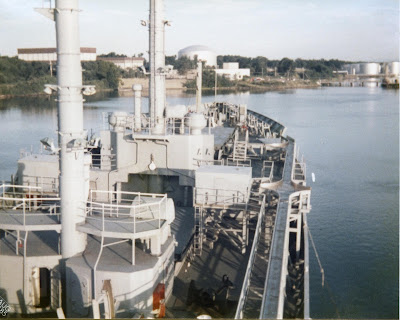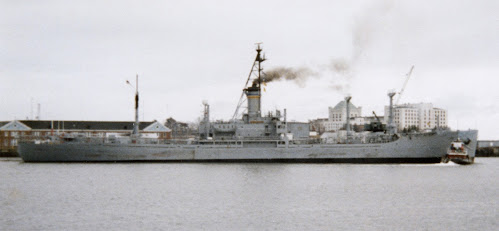The cable ship Furman rested at her dock at the Portsmouth Naval Shipyard in Kittery, Maine, on Saturday morning, March 15, 1986. Two tugboats nuzzled alongside her forward and aft and waited patiently as the old ship prepared to get underway and go to sea. Wisps of black smoke curled upward form her single stack into the gray overcast and light rain. The deck crew hauled in the gangway and the mooring lines, and then the tugs tooted their whistles in response to the pilot’s commands. Underway now on the Piscataqua River, the Furman eased away from the Navy Yard and headed downstream and seaward, bound for Guam.
Miss Patty and I watched the Furman’s departure from Prescott Park, on the opposite shore of the Piscataqua in Portsmouth, New Hampshire. I had served aboard this ship from June 10, 1985, to February 11, 1986. Most of this time had been spent slowly loading cable at the Simplex Wire and Cable Company pier in Newington, New Hampshire, a few miles upstream from Portsmouth. This process was interrupted several times by visits to the Navy Yard and by sea trials following some engine room repairs. When all of this was finished, a largely new crew came aboard to take the ship out to sea.
During her long visit to the Portsmouth area, the Furman served as a convalescent ship. Several of us in the crew were recovering from serious illnesses, and this was a pleasant and non-strenuous job. Many, like myself, lived nearby and commuted. The Furman was a good ship in a nice port close to home, and so she grew on me. I was sorry to see her sail away without me on that rainy Ides of March.
Memories of the Furman and my association with her have occupied my mind recently. As I often do when such thoughts linger, I started composing an essay discussing the ship, my time on board, and her subsequent departure. I had recorded some interesting information with detailed descriptions, and then disaster struck. By accidentally clicking the wrong thing on the computer, my essay was in one split second deleted forever. All attempts to recover the prose failed, and I had to accept the unpleasant fact that my composition, like the Furman herself, was irretrievably gone. How could such a thing happen? Quite easily. I’ve never been very comfortable with computers. Instead, I’ve always felt more at home communing with the Cosmos by gazing into the heavens and taking navigational sights from the bridge wing of a ship at sea.
But
not all was lost. Several photographs of
the Furman remained. Kept in a
separate file, these were unaffected by the fate that befell the essay. So while I am unable to reconstruct my
original writing, I am happy to present the pictures with some explanatory
notes.
These first two photographs feature the Furman at the Simplex Wire and Cable Company pier in Newington, in July of 1985. In the first, we are looking forward from the starboard bridge wing, and we see the foredeck and bow of the ship. The metal channel that runs along the starboard deck edge is a guideway through which the cable traveled when it was being loaded into the cargo holds.
Next, from the after end of the midships house, we see the stern section and the somewhat makeshift gangway.
Several months later, in February of 1986, and with the Furman realigned at the pier, we enjoy from shoreside a view of the ship from the midships house aft.
Now, from the stern of the Furman on a cold morning that same February, we watch the Sun rise over Kittery, Maine. The steel arch bridge carries Interstate 95 over the Piscatqua between Maine and New Hampshire.
Departure day, Saturday, March 15, 1986. With tugboats in position forward and aft, the Furman prepares to leave her berth at the Portsmouth Naval Shipyard in Kittery. This view and the one following were taken from Prescot Park, across the river in Portsmouth.
Underway and outward bound in this broadside view, the Furman departs from the Navy Yard.
Finally, the Furman heads out to sea in this view taken from Fort Constitution, downstream in New Castle, New Hampshire. Off the ship’s port side stands Whaleback Light in Kittery, one of the two lighthouses that mark the entrance to Portsmouth Harbor.






